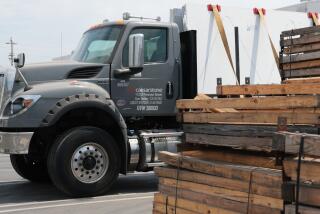Case Hinges on Material Witness
- Share via
To hear Kelly-Moore’s lawyer tell it, the Union Carbide salesmen had their mantra down: Don’t worry, they’d say, don’t worry.
Union Carbide Corp. was one of the companies that supplied Kelly-Moore Paint Co. of San Carlos, Calif., with the asbestos used as a thickening agent in its products. Mined in the Diablo Mountains north of Coalinga in Central California and refined at a mill in the Salinas Valley, Union Carbide’s trademarked Calidria was supposed to be different from the asbestos sold by competitors such as the former Johns-Manville Corp.
But Kelly-Moore now claims there was plenty to be worried about.
Union Carbide, it charges, fraudulently promoted Calidria as a uniquely safe alternative to potentially deadly types of asbestos. Kelly-Moore says Union Carbide had evidence linking the product to cancer and asbestosis but withheld it.
In a high-stakes trial underway in state court in Angleton, Texas (not far from Union Carbide’s Houston headquarters), Kelly-Moore is asking a jury to order the chemical giant to take responsibility for a huge chunk of the paint company’s exposure to 48,000 asbestos injury suits. Kelly-Moore wants actual damages of $1.3 billion -- its anticipated liabilities and legal costs -- plus punitive damages of $3.9 billion.
If Kelly-Moore loses, it could go bankrupt. If Kelly-Moore wins, the verdict could wipe out Union Carbide’s insurance coverage and help paint a bull’s-eye on the only solvent former asbestos producer in the United States, encouraging other companies that bought Calidria to take Union Carbide to court.
Two other former Union Carbide customers already have sued, saying, basically, what former workers at the company’s Calidria mill near the Salinas Valley town of King City recall being told: Don’t worry -- it’s not the bad stuff.
These corporate customers are a new type of plaintiff in a litigation blame game that has prompted more than 60 companies to seek bankruptcy protection. Until recently, most asbestos suits were product-liability and wrongful-death claims filed by individuals who blamed lung disease and cancer on asbestos fibers they inhaled on the job and in the home.
As the last former asbestos producer standing, Union Carbide, a part of the Dow Chemical Co. empire since 2001, maintains that it has become an expedient target, first for individuals and now for manufacturers who used the mineral in their products.
It denies misleading customers or mill workers and says they were warned of Calidria’s potential health hazards. Even so, Union Carbide’s lawyers say, Kelly-Moore had a responsibility to determine independently whether ingredients in its paints were toxic. And by the time Union Carbide began selling Calidria to Kelly-Moore in 1964, they contend, there was plenty of publicly available information linking asbestos with lung disease and cancer.
In any event, Union Carbide supplied only a fraction of the asbestos that Kelly-Moore used over the years; a Johns-Manville successor and Celotex Corp., which also sold asbestos to Kelly-Moore, filed for bankruptcy protection years ago. But “Kelly-Moore wants Union Carbide to pay for 100% of the choices it made,” Union Carbide lawyer Scott Lassetter said in his opening argument Sept. 13.
“This case is about scapegoating Union Carbide because both Union Carbide and Kelly-Moore are involved in more asbestos lawsuits than we’d like to even think about,” Lassetter said. “It’s a drain on the budgets of these companies to finance people like me. It’s simply something that these companies wish had never happened, but we can’t turn the clock back.”
Kelly-Moore’s lawyer, Mark Lanier, told jurors that they should, in fact, look back in time.
In the 1950s, he noted, Union Carbide was a member of the Industrial Hygiene Foundation, which commissioned a study that linked chrysotile, the type of asbestos sold by the company, to cancer. But then the group publicly reported just the opposite. And in the 1960s, he said, a few years after Union Carbide discovered the world’s largest cache of asbestos in California and opened its mill near King City, its own tests indicated that Calidria caused more damage to the lungs of rats than the asbestos sold by Johns-Manville.
“Instead of telling companies and people and stopping the asbestos market right there, they hide it,” Lanier told jurors. “They start pushing their asbestos in every product they can because, you see, that disease of asbestosis takes 20 or so years before you get it. The cancer takes 20, 30, 40 years before you get it. And these guys were going to make their killings right then.”
In the early 1970s, Lanier contended, Union Carbide began to realize that in a few years, its customers would recognize that what it was selling was a hazard and quit buying.
“So why don’t we, quote, ‘Make hay while the sun shines’?” Lanier said, referring to a memo in which Union Carbide considered building a larger mill to get asbestos to market more quickly.
Calidria was used in an array of products, including drilling mud, flooring and joint compound in the United States and concrete blocks in Japan. Today, Union Carbide faces tens of thousands of injury suits from people who say they were exposed to Calidria fibers released from those and other products. Union Carbide has estimated that it will cost nearly $2 billion to resolve all the claims, though it expects insurers to pick up much of that tab.
Because asbestos-related diseases can take decades to appear, analysts have said, Union Carbide’s asbestos litigation may not peak for another decade and could continue through 2027.
For years, Kelly-Moore defended itself against lawsuits filed by painters and laborers who had lung disease and cancer by arguing that Calidria didn’t cause disease.
But company executives changed their view of Calidria after meeting with Lanier -- a high-profile plaintiffs’ lawyer who had filed several suits against Kelly-Moore on behalf of asbestos victims -- and Dr. David Egilman, a specialist in occupational medicine who has become an expert witness for Kelly-Moore.
“Once Kelly-Moore had a chance to sit down and assess the other side of the story and read some documents that were internal to Union Carbide, Kelly-Moore began to have serious questions about whether the Union Carbide defense was true,” Lanier said in an interview. “It was almost like scales falling from their eyes and the blind seeing. They realized that they’d been duped.”
For its part, Union Carbide has presented an evolving view of Calidria through the years. While it was selling asbestos, the company says, it took the conservative approach and cautioned customers about its potential dangers. Indeed, Union Carbide’s vendor safety sheets list it as a carcinogen.
Today, however, the company says recent research shows that its asbestos doesn’t cause lung disease or cancer because its fibers are so short that they are swiftly expelled after a person inhales them. To underscore that point, in trials and interviews, Union Carbide has asserted that no King City mill worker has been determined to have an asbestos-related disease.
According to Lanier, Union Carbide’s current position that Calidria is safe is an extension of the company’s decades of misrepresentations -- not a new concept. And, he contends, the company’s assertion about the mill hands is “flat wrong.” In his opening argument in Texas, he cited corporate and public records that suggest that several workers’ lungs were affected by Calidria. What’s more, he said, the case of a former mill hand who died after heart surgery in 1991 was in part what spurred Kelly-Moore to go after Union Carbide.
The records, including notes handwritten by the mill’s manager at the time, showed that Union Carbide questioned the death certificate’s listing of asbestosis as a cause and expressed relief when the Santa Clara County coroner changed it to pulmonary fibrosis. Union Carbide contends that the company had nothing to do with the change.
In the 1980s and 1990s, Union Carbide maintained a low profile as an asbestos defendant, quietly settling most claims out of court as a member of the Center for Claims Resolution, a consortium of asbestos producers and manufacturers.
After most of its members filed for bankruptcy protection, the center dissolved, leaving Union Carbide on its own. And the number of suits against the company -- filed, for the most part, not by Union Carbide’s business customers but by users of products in which Calidria was an ingredient -- swelled.
So Union Carbide changed tacks: It began going to trial. In a handful of cases, jurors held the company liable for failing to adequately warn customers and users, but Union Carbide won several cases as well with the argument that its warnings were sufficient.
The first company to go after Union Carbide over asbestos liabilities was Conwed Corp., a ceiling tile maker that used Calidria from 1965 to 1974. Hundreds of cases of asbestosis and mesothelioma, a fatal cancer, have been reported among workers and their families at Conwed’s Cloquet, Minn., plant. Union Carbide settled many of their claims out of court. Then Conwed, facing daunting workers’ compensation claims, sued in 1992, alleging that Union Carbide wrongly billed Calidria as safe.
One jury found in Union Carbide’s favor, saying that regardless of what Calidria’s salesmen might have said, Conwed should have known the asbestos was hazardous. But last year, a second jury held Union Carbide liable for having failed to adequately warn Conwed of Calidria’s dangers, exposing Union Carbide to millions of dollars in damages from more than 100 asbestosis claims. The case is on appeal.
Conwed’s lawyer, Robert Brownson, said in an interview that Union Carbide oversold the research suggesting that its asbestos might have been less potent than other types of the mineral fiber.
“That’s like saying arsenic is not as bad as strychnine,” he said. “They’ve tried to push it too far and say it’s utterly safe.”
Until the last couple of years, much of Union Carbide’s role as a producer was largely hidden, said Christian Hartley, a Charleston, S.C., lawyer who has represented several dozen asbestos victims in lawsuits against the company. “No one knew the story about Union Carbide like they do now.”
In every case, the decision to litigate forced Union Carbide to divulge more documents that suggested concern for the bottom line amid growing awareness of asbestos’ dangers. One 1975 memo, for example, suggests that Union Carbide’s own lawyers had recommended that the company put “Cancer” on Calidria labels without waiting for a government mandate, which came a decade later.
The memo said the idea was rejected because it could hurt business: “We cannot predict with certainty what effect the use of the proposed label will have on our business but the general feeling here is that it is likely to vary somewhere between serious and fatal.”
In 1973, one of Union Carbide’s own medical advisors accused the company of misrepresenting Calidria as safe.
“This is misleading,” Dr. Kenneth Lane, the company’s assistant medical director, said in a memo, criticizing a marketing paper titled “Safe Use of Calidria RG-244.” “The discussion of the varieties of asbestos is interesting but irrelevant to the fact that all varieties produce disease.”
Union Carbide lawyers say that the company made corrections to the marketing paper to satisfy Lane’s concerns.
The trial in Texas is expected to run for at least six weeks. Many of the memos and documents that have surfaced in other cases are starting to come into evidence in this one.
Lassetter, Union Carbide’s lawyer, told the jury to be wary of what they might read.
“Nobody’s perfect,” he said. “You’ll find bad paper in any big corporation. But we never, ever did the things that we’re being accused of in this courtroom.”
More to Read
Inside the business of entertainment
The Wide Shot brings you news, analysis and insights on everything from streaming wars to production — and what it all means for the future.
You may occasionally receive promotional content from the Los Angeles Times.











